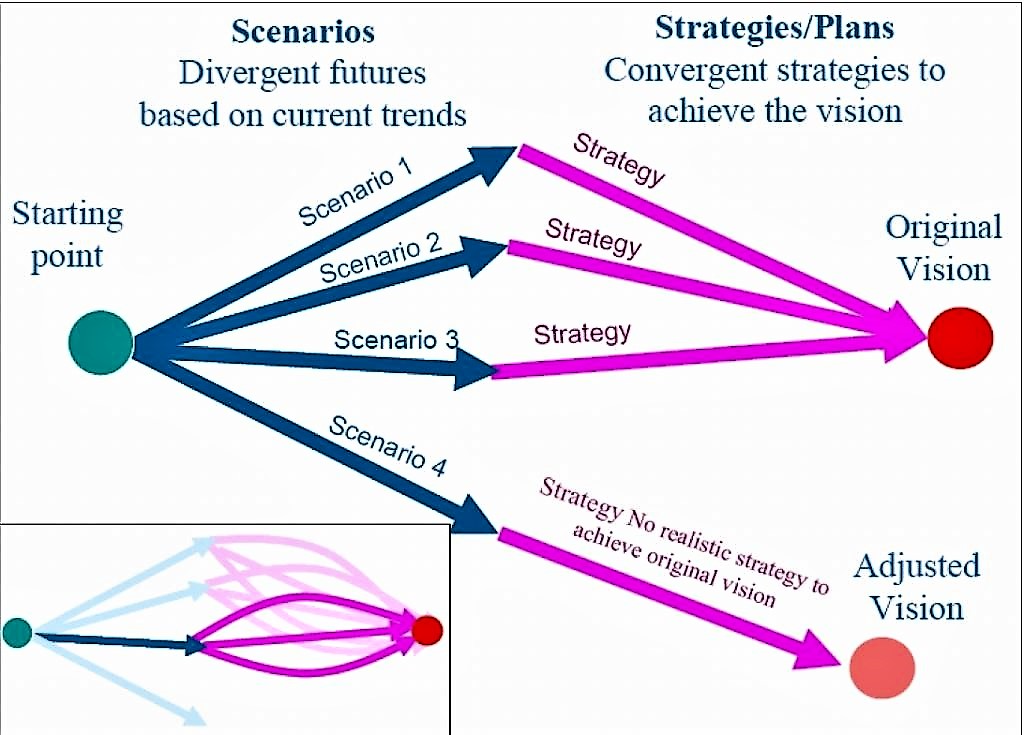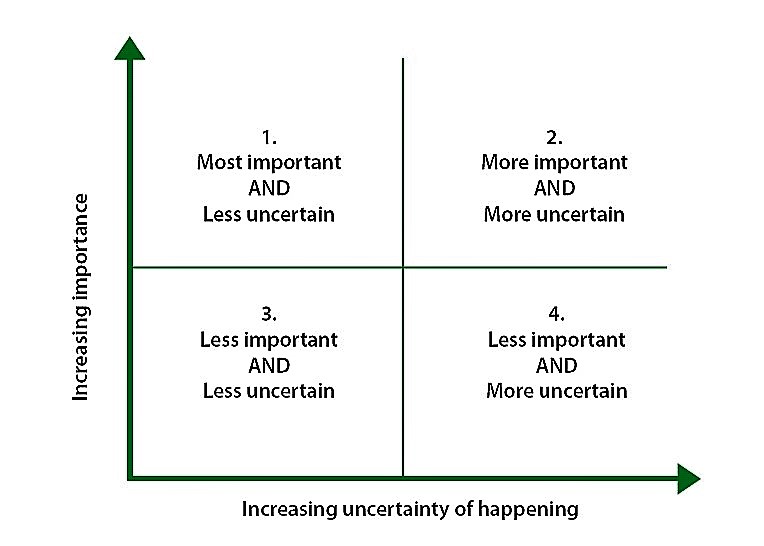Abstract
Global businesses operate in a highly uncertain environment that is constantly changing. As 2020 so far presented, various events ranging from a pandemic and a major economic recession to social unrests and environmental catastrophes can impact areas where businesses operate. Furthermore, the future is unpredictable with economies, technologies, and governments having the potential of rapidly shifting.
Traditional planning is based on forecasts that are rigid, and although can be accurate, do not take into account major shifts in influencing factors. One of the key aspects for a company to remain operational and adaptable in uncertainty is to be prepared, aware, and have contingency plans for possible outcomes. Scenario building is a critical tool that undertakes the analysis of current and historical trends to provide consistent narrative descriptions of possible future situations that can be used as pathways for future strategic decision-making.
General Information
A scenario can be described as a narrative about the state of the world in the future. Due to the numerous possibilities of future situations, scenarios are not specific, and it is virtually impossible to predict or combine all external and internal factors. Instead, scenarios are a plausible description of the state of the future that attempts to offer realistic predictions that can aid in long-term strategizing. It is important to consider the differences of scenario building from a company’s vision, which is instead a desired future state.
The main objective of scenario building is to identify risks, uncertainties, and constraints that can arise for a specific business or industry in the future. These can address elements of policy, infrastructure, costs, social perceptions, and economic changes among others. Awareness of these factors allows for more competent strategy development as it shifts the perspective from one future to a wide variety of alternatives. Furthermore, steps can be taken to develop strategies that are based on the scenarios to achieve the company vision as seen in the image below (Widler, n.d.).

Scenario building is frequently carried out by companies to understand and communicate the elements of strategy about the future to its stakeholders. Various methodologies are employed in the scenario building process, but it usually consists of two stages of research data and analysis followed by storytelling and communication. One major weakness is the transition between the phases where a loss of consistency and technical data is seen when compiling it into a generally understood narrative which can jeopardize its purpose and validity (Carbonell et al., 2017).
Scenario building requires preparatory work that can include vision development, stakeholder identification, and analysis. Scenarios are commonly created by utilizing a matrix as seen below in its most simple form. It lists external factors that are beyond the control of the organization and factors that are used to develop the scenarios as well as internal factors which are within the control of the stakeholders and can be applied strategically. Scenarios are commonly implemented at the beginning of planning processes which are used as a basis for identifying feasible strategies in the context of social, economic, political, and environmental predictions (Widler, n.d.).

Why is Scenario Building Needed?
For companies and organizations planning for the future, it is much easier to adapt to rapid changes and solve arising problems, even if their exact nature was not predicted. Scenario building is necessary for the main purpose of being a tool in which organizations can consider future changes, help decision-makers in reshaping strategies to correlate with the status quo, and identify trends that can potentially benefit or harm the company in the long term.
Scenario planning encourages system thinking in an organization, establishing preventive mechanisms to address issues, potentially before they occur, and identifying trends in the evolution of both external and internal factors that can influence a business. With the use of scenario building, companies can take advantage of being aware of various possibilities and engage optimal allocation of internal resources to match the external environment and potential future status of the company. Furthermore, there is the concept of risk reduction by addressing future uncertainties by identifying threats and weaknesses to the company, to better prepare in handling risks and challenging situations in the future.
Designing plausible scenarios is a prospective model that encourages discussion about futures and understanding the long-term consequences of company activities in the current time in the context of future realities. Scenario building must be plausible to help stakeholders navigate the dynamic uncertain environment since without understanding the context or having unrealistic descriptions may have contradictory effects in preparing for the future (Walton et al., 2019).
While most top managers consider the company’s future in their decision-making, it is commonly narrow, short-term, and individual. Scenario building is key for an organization to explore its strategies, resources, and options as without such preparation, it will be dependent on being able to respond to whatever challenges arise, which history shows to be seldom the case as even the largest corporations can go bankrupt due to sudden changes in the economy or social patterns.
Good Scenario Characteristics
Scenarios can vary, ranging from being broad and extremely long-term to more focused and examining trends in the next decade. Scenarios are usually categorized by key themes and time ranges. Several key characteristics should be present in scenario building. Multiple views of the future must be present, which is the objective of scenarios that differs them from forecasts.
Scenarios excel when addressing complex and highly uncertain situations where qualitative influences are most present such as social values, regulations, technology, and economic/consumer trends. Quantitative changes are difficult to predict after a certain period and more characteristic to forecasts, and it will be inaccurate for scenarios to engage in anything other than qualitative changes. That leads to the major characteristic that scenarios must remain objective, describing what could realistically happen instead of what the planners or company desires to happen.
Scenarios must be feasible and challenge broad thinking, which may leave them to be open-ended, without precise detail. However, they present objectively consistent narratives based on which a reader can conclude. Another characteristic is that scenarios must be focused and relevant to the status quo, focusing on the driving forces and uncertainties that are relevant to strategic decisions at hand (Brummell & MacGillivray, n.d.).
It is critical for scenarios to be grounded in facts and liked to events of past and present. The scenarios are not meant to be guides or forecasts, but rather consistent narratives that will present variation of opportunities and possibilities to decision-makers, expanding their mental maps of the long-term situation to ensure competent strategic actions. Shell as a company has historically been known for its experience and focus on scenario building. In its scenario building guide, it discusses the process as collaborative and widely available that facilitates an interplay of ideas. It allows to enable and combine various fields of knowledge and ways of knowing, reframing commonplace assumptions to challenge thinking or generate ideas.
Helpful elements in validating Shell’s scenario building include clarifying of objectives, consideration of external environmental disruptors, including value chains, use of analytic tools when appropriate, and decision recommendations based on hard and soft inputs. Shell builds sets of scenarios to assemble different versions of the future at the same time. Shell has scenarios as far as by the end of the century and addressing various elements of its energy and research portfolio (Shell International, 2008).
Presenting Scenarios
Scenarios can utilize a wide array of presentation tools and media to create and supplement the primary narrative. This includes everything from social media and blogs to official reports and statistics. Visual media such as infographics, posters, basic videos, and concept boards help maintain engagement with the audience and support a relatively complex narrative in the scenario.
According to Shell (2008), presenting scenarios to primary recipients is an important method of testing substance and allows for further refinement before final publications. Scenarios should not be presented as predictions or only available alternatives, since then the discussion will focus on details. Instead, scenarios must be presented in a manner that highlights underlying dynamics and implications. The process of communication scenarios is enabling the audience to visualize and experience the scenario, utilizing both narratives and visual elements to explain and relate complex aspects to the general audience.
References
Brummell, A., & MacGillivray, G. (n.d.). Introduction to scenarios. Web.
Carbonell, J., Sánchez-Esguevillas, A., & Carro, B. (2017). From data analysis to storytelling in scenario building. A semiotic approach to purpose-dependent writing of stories. Futures, 88, 15–29. Web.
Shell International. (2008). Scenarios: An explorer’s guide. Web.
Walton, S., O’Kane, P., & Ruwhiu, D. (2019). Developing a theory of plausibility in scenario building: Designing plausible scenarios. Futures, 111, 42–56. Web.
Widler, S. (n.d.). Scenario building. Web.
